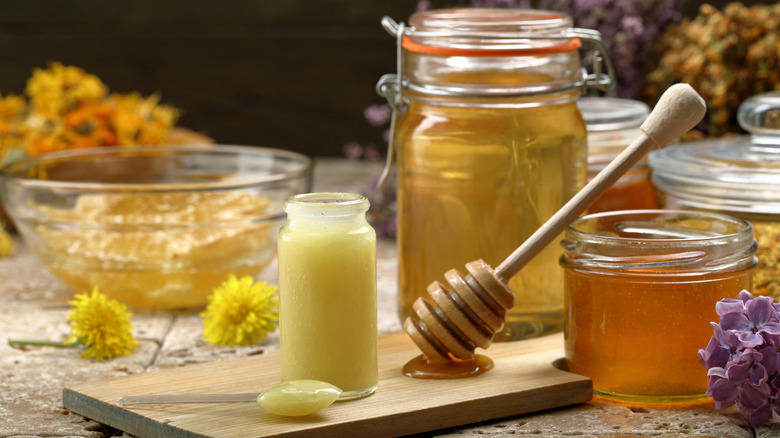What Is Royal Jelly And Why Is It So Expensive?
Although it's the most popular bee product, honey isn't the only treasure sourced from the hive. Enter royal jelly — the nutrient-rich substance made by worker bees that's prized for its potential health benefits and unique role in nurturing queen bees.
Royal jelly is an edible milky secretion produced by worker bees that serves as the sole food source for queen bees and enables their rapid growth and longevity. Unlike honey, which serves as an energy source for the hive, royal jelly plays a key role in influencing whether a larva will develop into a queen bee or a worker bee. All larvae are fed royal jelly at first, but worker bees decide which larvae will continue to receive it based on their potential to become a queen. Once she emerges, the queen continues feasting on royal jelly until her death, at which point the worker bees restart the cycle of selecting a new queen.
Teeming with essential nutrients, including proteins, B vitamins, healthy fatty acids, and antioxidants, royal jelly is a purported powerhouse for boosting immunity, promoting skin health, and supporting overall vitality. However, it's not nearly as accessibly priced as honey. Royal jelly can cost up to $125 per pound due to its labor-intensive harvest and the small quantities produced by bees. Extracting royal jelly is extremely tedious and can endanger worker bees along the way. Between its limited supply, high demand as a health supplement, and challenging extraction process, royal jelly is a pricey luxury.
Culinary uses for royal jelly
Royal jelly can be applied topically or consumed orally, but just because it's made by bees doesn't mean it has the same taste and culinary applications as honey. Royal jelly flaunts a unique flavor profile marked by creamy, sour, and delicately bitter top notes that are accented by whispers of acidic sweetness. Because of its complex and unfamiliar taste, royal jelly isn't frequently used in cooking and baking. However, it can work in some recipes.
Add a small spoonful of royal jelly to sippable treats like smoothies, juices, or teas for an extra nutritional boost and a tint of complexity. Stir royal jelly into yogurt or oatmeal for a creamy, nutrient-rich breakfast, or combine it with its sister sweetener, honey, and pour the elixir over a stack of buttermilk pancakes to receive all of its benefits without its peculiar taste. Use royal jelly to make homemade granola bars or other raw desserts like energy balls, no-bake cakes, or chocolate truffles.
Because extreme heat can damage its delicate properties, avoid using royal jelly in recipes that require high temperatures. Unlike honey, which never expires, royal jelly only lasts up to six months when stored in a refrigerator, so use this expensive bee delicacy before it goes south to get your money's worth.

